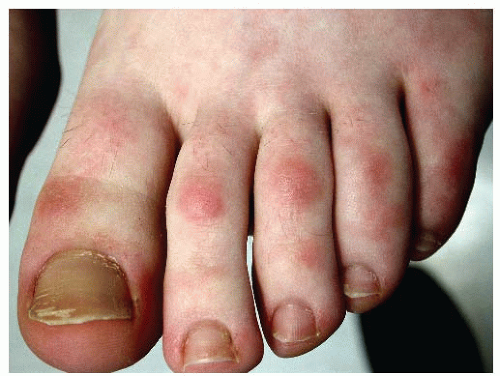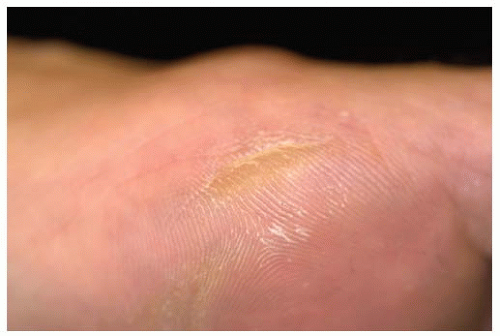Management of Corns and Calluses
Peter C. Schalock
Arthur J. Sober
Corns and calluses are common, vexing lesions that can interfere with daily living. They may not be a presenting complaint, but the primary care physician is frequently asked about them. The tasks in the primary care setting are to provide diagnosis, simple therapy, advice on prevention, and timely referral if symptoms are refractory or disabling.
Corns (helomata, clavi) and calluses (tylomata) have a common pathologic origin. Friction and pressure on the skin overlying bony prominences lead to hyperemia and proliferation of keratin. Corns often have a central, hard core that is painful if the lesion is pressed. Ill-fitting shoes are the most common cause, and the pressure of shoes on a corn may produce pain during walking (Fig. 189-1). Repeated friction may also cause callosities (Fig. 189-2).
The most common locations are on the lateral aspect of the small toe and over the metatarsal heads on the plantar aspect of the foot. Hard corns (heloma durum) (Fig. 189-3) have a translucent, cone-shaped avascular core with interruption of normal skin markings. Soft corns (interdigital heloma molle) appear as macerated white or gray lesions that are tender. The fourth and first interdigital web spaces are favored sites. Calluses, but usually not corns, may develop in persons who do not wear shoes. Calluses do not contain a central core and tend to occur across the area of the metatarsal heads; normal skin markings are preserved. Women are two and a half times more likely to be bothered by corns and calluses than are men.
 Figure 189-2 Callosities on the dorsal toes of an Irish step dancer.
Stay updated, free articles. Join our Telegram channel
Full access? Get Clinical Tree
 Get Clinical Tree app for offline access
Get Clinical Tree app for offline access

|


